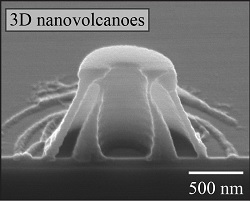 |
| A nanovolcano capable of storing and releasing drugs.--Courtesy of Chih-Hao Chang |
Researchers at North Carolina State University have used ultraviolet light to create what they call "nanovolcanoes," tiny cone-shaped structures that can store and release precise amounts of drugs.
The scientists began with transparent, spherical nanoparticles placed on a thin film that, when shone with an ultraviolet light, undergoes a chemical change, trapping drugs in a small mound with a hollow core. By controlling the wavelength of the light, the team was able to control the size and shape of the structures to dictate how big the inner cavity would be, according to the study, published in the journal ACS Nano.
By controlling the size of the cavity, the researchers are also able to control the size of the drug payload. And like a volcano, the structures have a hole at the top, the size of which controls the rate of release. The team is continuing to study how the nanovolcanoes release drugs and how fast materials are able to escape from the mouth.
"The materials used in this process are relatively inexpensive, and the process can be easily scaled up," said study co-author Chih-Hao Chang in a statement. "In addition, we can produce the nanovolcanoes in a uniformly patterned array, which may also be useful for controlling drug delivery."
The research drew funding from NASA and the National Science Foundation.
- here's the NC State report
- get the research abstract